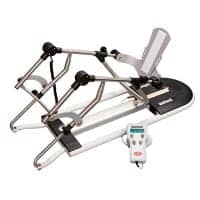
In the last “ICC Prep” article, Robert Hajazi and I began to explain hospital networks, such as where networks may be located along with their primary function and some simple troubleshooting tips. With this information covered, it is time to move on to information about networks that you may see on the CBET exam. Questions on the CBET exam that cover “networking” will not require a network engineer’s knowledge base. However, there are several areas of networking that must be mentioned to prepare you for the challenge of becoming certified.
This article will cover different devices used in a network and some of the terminology used to describe some of these devices. Let us begin with hubs, switches, routers, and servers. Hubs are nothing more than a repeater of packet information on the network. However, hubs do not manage packet traffic and are susceptible to packet collisions, which will slow the data traffic on the network. Hubs are rarely used with the more sophisticated networks employed today.
Switches connect network segments and will often be referred to as network bridges. These network devices process and route information data packets on the network. Unlike their passive counterparts—hubs or repeaters—switches are active devices that minimize data packet collisions, which aids in the speed of data transfer on the network. Routers are network devices that connect very large networks such as Internet service providers (ISPs). The term “router” may also be used to describe a residential gateway. These “routers” are employed to connect home networks to a digital subscriber line (known as DSL), or coax, or fiber optic cable network. This type of residential gateway or router makes all the connected computers look like one device to the network.
Servers
Next, we have servers. Servers are a combination of software and hardware that connect services to network clients. Internet servers provide services to clients such as the worldwide Web, domain name servers (DNS), e-mail, file transfer protocol (FTP), chat, instant messaging, and voice and online gaming, to mention a few. Hubs, switches, routers, and servers are the gateway devices used in networking to route information on networks.
With networking being a relatively recent technology biomedical/clinical engineering personnel must deal with, it is harder to pinpoint where questions may come from. I can certainly say most CBET exams will have questions about ground wire resistance and leakage current limits, but it is much more difficult to predict the focus of the networking questions. With that in mind, be familiar with each of these network pathway devices and the nomenclatures mentioned above such as DSL or FTP.
NIC, MAC, and TCP/IP
To better prepare you for networking questions, we will now look a little deeper into some areas of the last “ICC Prep” article, including network interface controllers or NIC cards; media access control, or MAC, addresses; and Transmission Control Protocol and Internet Protocol, referred to as TCP/IP, which is a set standard of protocols for data communications on most all networks.
The TCP/IP protocol allows different computers running different operating systems and software, such as a Mac or PC-type computer, to communicate with one another. NICs are the devices on your computer that are physically connected to the network with a coax, AUI, or most likely a CAT 5 or CAT 6 cable connection. NIC cards are rated by their transfer rates of data on the network as 10/100/1000, with these numbers referring to the transfer rates of the device in megabits per second. Remember that the NIC card is where the MAC address is burned into a ROM chip to uniquely identify the computer on a network. The MAC address is a 48-bit hardware identifier of the computer, but it can also be used in MAC address filtering to help ensure security on a network. MAC addresses are static addresses and can be used to allow or disallow a computer onto a network. Think of the MAC address as your street address; it is the physical address of the computer. IP addresses are often referred to as the physical address of the computer, but IP addresses are often dynamic addresses, meaning a new IP address is assigned to the computer by the ISP from a pool of addresses, but the MAC address will never change unless you replace your NIC card.
As mentioned earlier, networking is a relatively new technology compared to, say, ECGs, and it is changing extremely fast. A good example would be hardwired networks and wireless networks. Wireless seems to be taking over at an astonishing rate as the technologies continue to emerge. The information presented here may not be the most advanced, but it is correct and will most likely be what is covered by the CBET exam.
John Noblitt, MAEd, CBET, is the BMET program director at Caldwell Community College and Technical Institute, Hudson, NC. For more information, contact .
Review Questions
- A DSL is a _________________________________.
- Digital subscriber line
- Digital synchronous line
- Digital subscriber local area network
- None of the above
- A computer’s MAC address is found where?
- In the computers BIOS
- On the Internet
- In the ROM on the NIC card
- All of the above
- NIC cards are rated by the speed in which they can transfer data and is stated in _______________________.
- Millibytes per second
- Megabytes per second
- Megabits per second
- Megabits per minute
- Which device connects services to clients?
- Hub
- Switch
- Repeater
- Server
See the answer
See the answer
See the answer
See the answer





